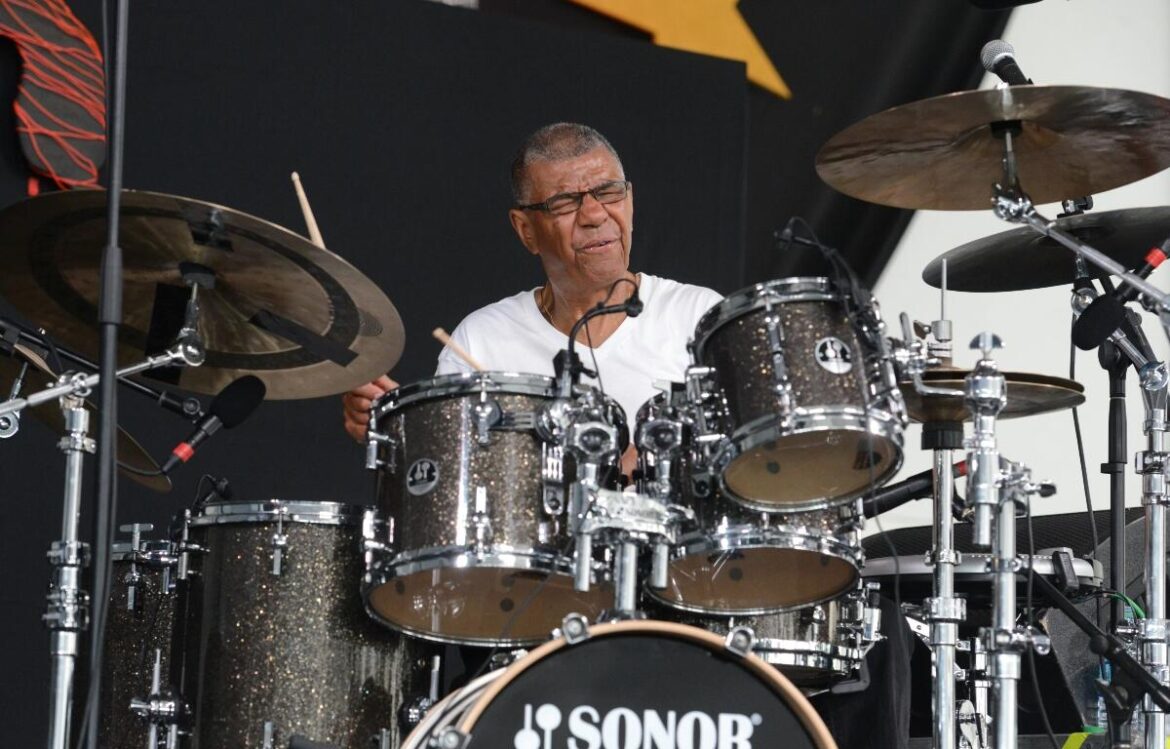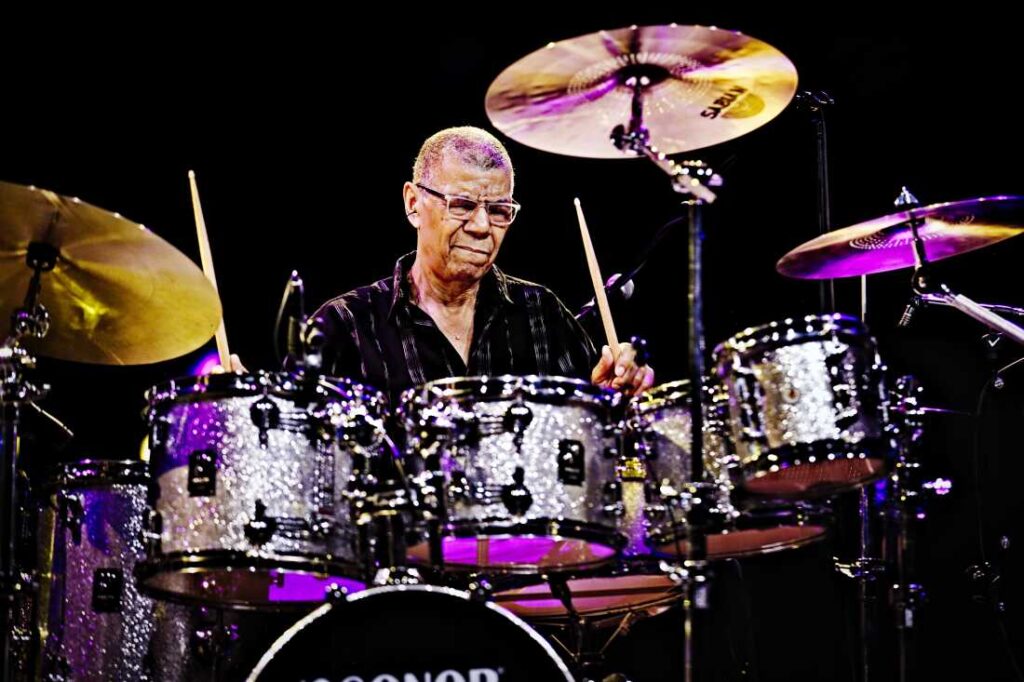
Jack DeJohnette (August 9, 1942 – October 26, 2025) was an American jazz drummer, pianist, and composer whose innovative, fluid style and boundless versatility made him one of the most influential percussionists in the history of modern jazz.
Spanning over six decades, his career bridged the avant-garde and the mainstream, fusing the rhythmic sophistication of post-bop with the freedom of experimental improvisation and the power of rock and world music.
Known for his profound sensitivity, rhythmic elasticity, and deep musical intelligence, DeJohnette played a pivotal role in shaping the sound of jazz from the late 1960s onward. His collaborations read like a who’s who of 20th-century jazz — Miles Davis, Keith Jarrett, Charles Lloyd, Freddie Hubbard, John Abercrombie, Herbie Hancock, Bill Evans, and countless others — each partnership revealing new dimensions of his artistry.
Early Life and Musical Foundations
Jack DeJohnette was born on August 9, 1942, in Chicago, Illinois, a city whose rich musical scene provided fertile ground for his developing talents. He began studying classical piano at the age of four, a foundation that would deeply inform his approach to rhythm and harmony throughout his career. As a young man, DeJohnette immersed himself in the vibrant Chicago jazz and blues scene of the 1950s, absorbing the traditions of hard bop, soul jazz, and the emerging avant-garde movement.
Though piano was his first instrument, he found himself increasingly drawn to percussion during his teenage years. By the time he reached his twenties, he was performing regularly around Chicago, alternating between piano and drums depending on the gig. His dual instrumental fluency gave him a rare perspective on ensemble playing — he thought like a composer and melodicist even when behind the kit.
During the early 1960s, DeJohnette performed with local legends such as Richard Abrams and Roscoe Mitchell, who would later become founding members of the Association for the Advancement of Creative Musicians (AACM). This exposure to free improvisation and compositional experimentation profoundly shaped DeJohnette’s musical outlook. He learned to view drumming not just as timekeeping, but as an expressive, compositional element — a way of engaging in dialogue with the entire band.
Breaking Through: The Charles Lloyd Quartet
Jack DeJohnette’s national breakthrough came in the mid-1960s when he joined the Charles Lloyd Quartet. The group, featuring Lloyd on saxophone, pianist Keith Jarrett, bassist Cecil McBee (later Ron McClure), and DeJohnette on drums, quickly became one of the most popular and groundbreaking ensembles of the era. Their 1966 album Forest Flower: Charles Lloyd at Monterey captured their energetic blend of jazz, rock, and global influences, earning widespread acclaim and commercial success.
The quartet’s openness to experimentation resonated with the spirit of the times — bridging jazz’s deep roots with the psychedelic and folk-rock sensibilities emerging from San Francisco and beyond. DeJohnette’s drumming was central to this appeal: fluid yet powerful, capable of driving complex polyrhythms while maintaining a sense of spontaneous conversation. His playing could be both meditative and explosive, reflective of his deep grounding in multiple musical traditions.
The partnership also began DeJohnette’s lifelong musical friendship with Keith Jarrett, whose interplay with him would become one of the most celebrated relationships in modern jazz.
Miles Davis and Bitches Brew
By 1969, Jack DeJohnette’s growing reputation caught the attention of Miles Davis, who was in the midst of reinventing his sound. Davis invited him to join the band, and DeJohnette’s contributions to Bitches Brew (1970) and Live-Evil (1971) became defining moments in the fusion of jazz and rock. His drumming on these recordings was revolutionary: merging the groove-oriented power of rock with the improvisational elasticity of jazz. He didn’t merely keep time — he shaped it, creating a dynamic, shifting pulse that propelled Davis’s ensemble into new sonic territories.
DeJohnette’s time with Miles Davis was brief but transformative. It taught him how to sustain intensity and groove over long forms, how to embrace technology and texture, and how to balance discipline with freedom. Davis’s bands were crucibles of innovation, and DeJohnette emerged from this experience as one of the most forward-thinking drummers of his generation.
Band Leader and Composer
In the early 1970s, Jack DeJohnette stepped confidently into the role of bandleader, recording a string of albums that showcased his range as a composer and multi-instrumentalist. His 1968 debut, The DeJohnette Complex, was a fearless exploration of rhythm and texture, featuring both his drumming and his piano work. Subsequent albums such as Sorcery (1974), Pictures (1976), and New Directions (1978) revealed his evolving interest in electronic textures, world rhythms, and the blending of genres.
DeJohnette’s music as a leader often transcended stylistic boundaries. He drew from funk, rock, Indian and African rhythms, avant-garde abstraction, and the lyricism of ballads. His 1970s group Directions, and later Special Edition — featuring musicians like David Murray, Arthur Blythe, and Chico Freeman — became platforms for forward-looking, politically aware, and highly expressive jazz.
Special Edition, formed in 1979, was especially important. It balanced strong melodies with avant-garde improvisation and introduced new generations of players to Jack DeJohnette’s ethos of exploration. The band’s rotating lineup over the years included some of the most creative young talents in jazz, and its recordings for ECM and other labels were widely acclaimed for their clarity and boldness.
The Keith Jarrett Trio: A Legendary Partnership
While DeJohnette was always active as a leader, one of the central pillars of his career was his collaboration with pianist Keith Jarrett and bassist Gary Peacock in the Standards Trio. Formed in 1983, this trio became one of the most beloved and influential small groups in jazz history.
.
Their mission was deceptively simple: to reinterpret the Great American Songbook and jazz standards through deep collective improvisation. But under Jarrett’s direction, and with DeJohnette’s and Peacock’s telepathic interplay, the trio elevated this concept into a new art form. Their concerts were celebrated for their emotional range — from breathtaking delicacy to volcanic energy — and their ability to make even the most familiar songs sound newly discovered.
Jack DeJohnette’s drumming in the trio was masterful in its restraint and intuition. He could create momentum without volume, intensity without aggression. His cymbal work was particularly admired — shimmering, whispering, or surging like waves, always attuned to the unfolding narrative of the music. The trio recorded extensively for ECM Records, producing landmark albums such as Standards, Vol. 1 (1983), Still Live (1986), Whisper Not (1999), and The Out-of-Towners (2004).
Their partnership lasted over three decades, making it one of the longest-running and most cohesive trios in jazz. Critics and musicians alike hailed it as the modern equivalent of the Bill Evans Trio — a model of group improvisation and mutual listening.
Collaborations and Side Projects
Beyond the trio, Jack DeJohnette’s list of collaborators is staggering. He worked with nearly every major figure in postwar jazz, often serving as the rhythmic linchpin for groundbreaking sessions.
He played with Bill Evans in the late 1960s, bringing a new rhythmic flexibility to Evans’s lyrical style. He worked with Sonny Rollins, Joe Henderson, Freddie Hubbard, Herbie Hancock, and Michael Brecker, each time adapting his sound to the unique demands of the music.
Jack DeJohnette also had a long association with John Abercrombie, Pat Metheny, and John Scofield, forming trios and quartets that explored fusion, acoustic jazz, and atmospheric soundscapes. His partnership with Alice Coltrane in the 1970s deepened his spiritual approach to music — one that valued transcendence as much as virtuosity.
In the 2000s and 2010s, he continued to push boundaries. His Trio Beyond project with Larry Goldings and John Scofield paid homage to Tony Williams’s Lifetime while reimagining fusion with a modern sensibility. In 2016, his album In Movement (with Ravi Coltrane and Matthew Garrison, the sons of his former collaborators) bridged generations and reaffirmed his commitment to evolution and continuity.
Style and Influence
Jack DeJohnette’s drumming defied easy categorization. He could play with the swing and subtlety of Elvin Jones, the crisp articulation of Tony Williams, and the coloristic touch of Paul Motian — yet his sound was unmistakably his own. His playing often blended rhythmic complexity with a sense of spaciousness, allowing the music to breathe.
He viewed the drum set as a melodic instrument. His approach to cymbals, in particular, was painterly — layering textures and tones that created a shimmering sonic environment. He was equally adept at explosive polyrhythms and delicate brushwork, and his time feel was elastic yet grounded.
His background as a pianist gave him a unique understanding of harmony and form. This allowed him to anticipate shifts in a composition and to play in dialogue with the soloists, not merely accompanying them but engaging them in conversation. Many musicians described playing with DeJohnette as a liberating experience — he gave them both structure and freedom.
Jack DeJohnette was also one of the earliest jazz drummers to embrace electronic percussion. In the 1970s and 1980s, he incorporated synthesizers and electronic pads into his setup, exploring ambient and world-music textures long before they became fashionable. This openness to technology reflected his belief that jazz should evolve with the times.
Awards and Recognition
Throughout his career, Jack DeJohnette received numerous accolades. He won two Grammy Awards and was nominated for six more. In 2007, he was inducted into the Modern Drummer Hall of Fame, an honor recognizing his unparalleled contributions to drumming.
He received the NEA Jazz Masters Fellowship in 2012 — the highest honor for an American jazz musician — celebrating his lifetime of innovation and mentorship. His albums for ECM and other labels consistently ranked among critics’ best-of-year lists, and his influence extended far beyond jazz, inspiring drummers in rock, fusion, and world music alike.

Personal Life and Later Years
Despite his global career, Jack DeJohnette remained deeply connected to his roots. He lived for many years in Woodstock, New York, a creative hub that fostered his collaborations and allowed him to focus on composing. He was known for his humility, spiritual outlook, and mentorship of younger musicians.
Even in his later years, DeJohnette remained active and forward-thinking. He continued recording and performing into his eighties, often appearing at major festivals and collaborating with younger generations who revered his artistry. His later projects reflected a reflective, meditative side — music that was as much about space and silence as rhythm and pulse.
Jack DeJohnette died on October 26, 2025, at the age of 83. His death marked the end of an era — the departure of one of jazz’s last great bridge figures, connecting the post-bop golden age to the open frontiers of modern improvisation.
Legacy
Jack DeJohnette’s legacy is monumental. Few drummers have contributed so profoundly to so many eras and styles of jazz. His work with Charles Lloyd and Miles Davis helped define the sound of the late 1960s. His leadership in Special Edition and Directions pushed the boundaries of creative expression. His decades with Keith Jarrett and Gary Peacock set a new standard for trio interaction and musical empathy.
Beyond his recordings, DeJohnette’s influence can be heard in the playing of countless drummers — from Brian Blade and Jeff Ballard to Eric Harland and Mark Guiliana. They inherited his balance of fire and finesse, his melodic approach to rhythm, and his commitment to growth.
More than a drummer, Jack DeJohnettewas a musical thinker — a composer, a sound sculptor, and a seeker. He viewed jazz as a living, breathing art form, constantly expanding in dialogue with the world. His music continues to inspire listeners and musicians alike to pursue that same openness, curiosity, and humanity.
Check out Jack DeJohnette on Amazon by clicking here.
If you found this interesting please share it with your friends and family, and check out some of our other articles on Musicians who Died in 2025.
.

